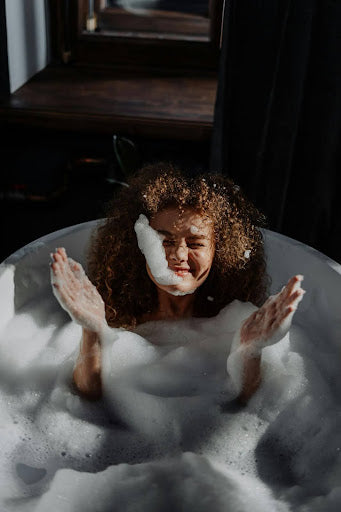For the curly girlies, here’s everything you need to know about hair extensions
When it comes to adding length or volume to your hair, one of the best ways to do it is with hair extensions. But, it’s not just people with pin-straight, thinner hair who might be after that added oomph – even those of us with full, super curly hair might be dreaming of even more length, or more curls. No matter your hair texture, if you want full, voluminous waves from your hair extensions, choosing ones that are already curled can save you tons of styling time.
Whether you're looking for length, volume, or fuss-free curls, we've got the scoop on how to achieve it without sacrificing your natural texture. From clip-ins to sew-ins and everything in between, we're debunking myths, sharing tips, and exploring the place where curly hair meets extensions. So, grab your favorite curly hair products and get ready to turn heads.
What makes curly hair different from straight hair?
Let’s start with the science. Straight hair, as you might have guessed, follows a straight path from root to tip. Each strand sits alongside all the other strands on your head for a sleek and smooth finish. Curly hair, on the other hand, bends and twists in all directions, creating spirals, coils, and waves that add dynamic texture and volume.
At a microscopic level, the difference is in the shape of the hair follicle and the arrangement of protein bonds within each hair shaft. Straight hair has round hair follicles and a symmetrical protein structure, so light reflects off of it evenly for a shiny, mirror-like finish. Meanwhile, curly hair typically has an oval-shaped follicle, along with an asymmetrical protein arrangement, so light scatters when it hits it, giving curls their characteristic matte appearance.
Whether you have straight or curly hair, each hair type brings its own unique charm (and challenges) to the table. It’s all about celebrating the diversity of your hair and rocking whatever makes you feel like your best self.
What are the different kinds of curly hair extensions?

Just like there are different types of hair (and different types of curls) out there, there's a whole range of curly hair extensions to match your unique style. Read on for the different kinds of curly hair extensions to find out which ones might be right for you!
– Clip-in extensions: the quick and easy way to add instant length and volume to your curls. These ones come in various curl patterns, from loose waves to tight coils, allowing you to mix and match for a seamless blend with your natural hair.
– Sew-in extensions: where bundles of curly hair are meticulously sewn onto braids or a hair net for a more long-term solution. Perfect for people who want their curls to last for an extended period with minimal maintenance.
– Tape-in extensions: lightweight strips of hair that are taped close to the scalp, blending seamlessly with your curls for a natural look. Plus, they're gentle on your hair and easy to remove when you're ready for a change.
– Crochet extensions: where strands of curly hair are looped through your natural hair using a crochet hook. It's a versatile option that allows for different curl patterns and textures, giving you endless possibilities to switch up your look.
To make the right choice, think about whether you’re looking for a temporary boost or a long-term commitment. Then, consider your curl pattern – let’s dive into that next!
How do you match curly hair extensions to your curl pattern?
Just like finding your perfect shade of lipstick, it's all about finding what’s right for you. First things first, determine your curl pattern. Do you have looser waves, bouncy curls, or tight coils? If you’re not sure, the best way to get to the bottom of it is by checking out a curl pattern chart or by asking your trusty stylist to assess your hair.
Then, browse through a variety of curly hair extensions, paying close attention to the curl pattern, texture, and length. Many brands offer extensions in various curl types, from 2A to 4C, so you're bound to find a spot-on match.
Next, consider the texture and density of your natural hair. Is it fine and silky, or thick and coarse? Of course, you’ll want your extensions to match the texture of your own hair so you get that seamless blend. It will also help if your hair is thick enough to hide the extension wefts, and you’ll get the best results if it’s at least chin length.
On to color. Match the extensions to the darkest shade at the roots of your hair for a natural-looking blend. If your hair has highlights or lowlights, choose extensions with similar undertones to achieve that perfect harmony.
Lastly, don't be afraid to mix and match! Sometimes a blend of different curl patterns can create a more realistic look, especially if your natural hair also has multiple textures and lengths, which is often the case.
How do I insert curly hair extensions?
Adding in your curly hair extensions depends on the kind of hair extensions you’re going with.
For clip-ins and tape-ins, the best way is to work from the bottom up, clipping the first weft in upside down to stop any of your shorter natural hairs from slipping through. Top tip: try mixing and matching different curl patterns into your hair to match its different curl patterns – most people with curly hair have at least two going on.
For sew-ins, your natural hair gets braided and the extensions are sewn into those braids. This means you can choose whatever curl pattern (or even no curl) your heart desires. With rochet extensions, since they get looped through and sit directly alongside your natural hair, matching is more important. Try to choose curls that are as close as possible to your natural type.
No matter what kinds of extensions you’ve chosen, be sure your natural hair is completely dry before you start! Also, it’s best to start with clean, conditioned hair. And a friendly reminder – when you are opening up your hair extension packaging, be gentle with the extensions and separate the curly hairs one at a time so you don’t disrupt the pattern too much!
What’s the best way to care for curly hair extensions?

So… can I get curly hair extensions?
From matching your curl pattern to mastering the art of care and styling, remember that embracing your natural texture is always a good idea. Whether you're flaunting bouncy curls, sleek waves, or tight coils, own it with confidence. Curly hair extensions are more than just an accessory; they're a celebration of diversity and individuality.




